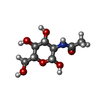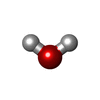+Search query
-Structure paper
| Title | Vaccine-elicited and naturally elicited antibodies differ in their recognition of the HIV-1 fusion peptide. |
|---|---|
| Journal, issue, pages | Front Immunol, Vol. 15, Page 1484029, Year 2024 |
| Publish date | Nov 14, 2024 |
 Authors Authors | Mateo Reveiz / Kai Xu / Myungjin Lee / Shuishu Wang / Adam S Olia / Darcy R Harris / Kevin Liu / Tracy Liu / Andrew J Schaub / Tyler Stephens / Yiran Wang / Baoshan Zhang / Rick Huang / Yaroslav Tsybovsky / Peter D Kwong / Reda Rawi /  |
| PubMed Abstract | Broadly neutralizing antibodies have been proposed as templates for HIV-1 vaccine design, but it has been unclear how similar vaccine-elicited antibodies are to their naturally elicited templates. To ...Broadly neutralizing antibodies have been proposed as templates for HIV-1 vaccine design, but it has been unclear how similar vaccine-elicited antibodies are to their naturally elicited templates. To provide insight, here we compare the recognition of naturally elicited and vaccine-elicited antibodies targeting the HIV-1 fusion peptide, which comprises envelope (Env) residues 512-526, with the most common sequence being AVGIGAVFLGFLGAA. Naturally elicited antibodies bound peptides with substitutions to negatively charged amino acids at residue positions 517-520 substantially better than the most common sequence, despite these substitutions rarely appearing in HIV-1; by contrast, vaccine-elicited antibodies were less tolerant of sequence variation, with no substitution of residues 512-516 showing increased binding. Molecular dynamics analysis and cryo-EM structural analysis of the naturally elicited ACS202 antibody in complex with the HIV-1 Env trimer with an alanine 517 to glutamine substitution suggested enhanced binding to result from electrostatic interactions with positively charged antibody residues. Overall, vaccine-elicited antibodies appeared to be more fully optimized to bind the most common fusion peptide sequence, perhaps reflecting the immunization with fusion peptide of the vaccine-elicited antibodies. |
 External links External links |  Front Immunol / Front Immunol /  PubMed:39611147 / PubMed:39611147 /  PubMed Central PubMed Central |
| Methods | EM (single particle) |
| Resolution | 2.3 Å |
| Structure data | EMDB-41461, PDB-8tox: |
| Chemicals |  ChemComp-NAG:  ChemComp-HOH: |
| Source |
|
 Keywords Keywords | VIRAL PROTEIN/ANTIVIRAL PROTEIN / IMMUNE SYSTEM / complex / viral antigen / antibody / VIRAL PROTEIN / VIRAL PROTEIN-ANTIVIRAL PROTEIN / IMMUNE SYSTEM complex |
 Movie
Movie Controller
Controller Structure viewers
Structure viewers About Yorodumi Papers
About Yorodumi Papers






 human immunodeficiency virus 1
human immunodeficiency virus 1 homo sapiens (human)
homo sapiens (human)